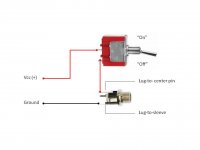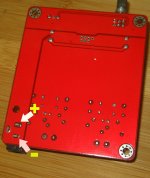Not weird ! This is lack of understanding, sorry. If you connect a device without switch of course it will spark (certainly with DC). That is one of the reasons switches were invented. If you put the DC plug in the boards connector first and then put the mains plug in the wal socket you will have better results. If you continue to do it otherwise you will notice burn marks at the DC connectors very soon. If stuff is gold coated, well that won't last for long 😉
BTW this counts for most if not all electronic devices with power adapters/wall warts. So also for laptops, cell phones and such. First DC plug in device, then AC plug in mains.
A power switch at the mains AC side would be best though as switching DC is tougher for switches. The contacts will "weld" to each other when larger currents are switched.
BTW this counts for most if not all electronic devices with power adapters/wall warts. So also for laptops, cell phones and such. First DC plug in device, then AC plug in mains.
A power switch at the mains AC side would be best though as switching DC is tougher for switches. The contacts will "weld" to each other when larger currents are switched.
Thanks for your reply 🙂
2ohm means I have to use two 4ohm speakers and parallel them to get 2ohms 🙁
I don't think that's a good choice.
Can you suggest me a amp kit to drive a 4 ohm speaker with 100W power?
try it with one 4 ohm speaker.
i have 12" 4 ohm 93 db horn-hybrid-sub running on a red board in pbtl.
it makes dishes jump and neighbours dance.
Today I put the new YJ blue board into a test / break-in chassis to hear how it does in its stock form. I'm using a Meanwell 6A power supply trimmed to 22V and running a burn-in disc into a 4 Ohm load for a couple of days before I do any real listening or comparisons with the others.
Do you find that burn-in makes a difference? I thought that was mainly for quality control to check for infant mortality on parts for high reliability systems? For drivers it's a whole can of debatable worms that is still on going with debate.
Do you find that burn-in makes a difference?
I did a "controlled burn-in" for a TA2021B a while ago. Permanently playing up to 300 hours, with daily listening.
Initial changes showed after 30 hours, the sonic signature began to settle around 70-100 hours, some minor improvements between 150 to 200 hours. No further changes after 200-300 hours.
But I didn't do it for a TPA chip so far.
Thanks Jean Paul.
The switch and an off board connector will be going on this morning. I guess what's weird is that I never noticed this happen before 😱
The switch and an off board connector will be going on this morning. I guess what's weird is that I never noticed this happen before 😱
Thanks Jean Paul.
The switch and an off board connector will be going on this morning. I guess what's weird is that I never noticed this happen before 😱
I always leave mine plugged in and on permanently. No popping noise that way. When I plug the laptop cord into wall outlet it appears to spark also. It looks like there is a large turn on transient that draws power and then settles.
Plop sound when i switch on power
Hi,
I don't know if i am on the good place to ask my question.
I just bought a TPA3116 amplifier board, this one:
TPA3116 Class D Amplifier Board 50W 50W Filter Capacitor 2×10000UF DC18V 24V | eBay
I use a 24V power supply.
When i have the potentiometer at max and i turn on power, i have a big "plop" in speakers.
Is it normal ?
Thanks
Hi,
I don't know if i am on the good place to ask my question.
I just bought a TPA3116 amplifier board, this one:
TPA3116 Class D Amplifier Board 50W 50W Filter Capacitor 2×10000UF DC18V 24V | eBay
I use a 24V power supply.
When i have the potentiometer at max and i turn on power, i have a big "plop" in speakers.
Is it normal ?
Thanks
Today I put the new YJ blue board into a test / break-in chassis to hear how it does in its stock form. I'm using a Meanwell 6A power supply trimmed to 22V and running a burn-in disc into a 4 Ohm load for a couple of days before I do any real listening or comparisons with the others.
If you don't mind a couple of questions, What is the pot you wired there for volume control, and what is the purpose of the resistor on the outside of the pot.
Sorry for the newb questions, but I don't want to burn my boards up doing something stupid...
Thanks
JOhn
If you don't mind a couple of questions, What is the pot you wired there for volume control, and what is the purpose of the resistor on the outside of the pot.
Sorry for the newb questions, but I don't want to burn my boards up doing something stupid...
Thanks
JOhn
Sure. The pot is an older 20K Vishay conductive plastic which facilitates an adjustable taper that is determined by the value of the R.
Could someone kindly explain the best way to connect an off board ac connector and switch. I'm afraid I just can't figure it out. 😕
Better switch AC (at the mains side of the power supply) as switching DC will have the switch living shorter. Also one does not want higher DC resistance after a while.
As DC tends to want to keep current flowing opening contacts results in arcing (the current wants to continue and tries to do so via air). Arcing makes pits in the surface of the contacts. Pits in the surface make higher contact resistance and a higher chance for reliability problems.
This was al common knowledge before the chinese revolution...
As DC tends to want to keep current flowing opening contacts results in arcing (the current wants to continue and tries to do so via air). Arcing makes pits in the surface of the contacts. Pits in the surface make higher contact resistance and a higher chance for reliability problems.
This was al common knowledge before the chinese revolution...
HI,
I bought the blue YJ board bought for my girlfriend. As I already have a L15D, I will be able to compare the amps.
I bought the blue YJ board bought for my girlfriend. As I already have a L15D, I will be able to compare the amps.
Don't use 2x 10kuf caps with a linear power supply. At least I wouldn't... not for these amps.
Thanks rhing- The problem I was having was how to connect it to the amp. I tried connecting wires on the bottom side of the on board connector but couldn't figure out which of the 3 contacts to use.
Thanks rhing- The problem I was having was how to connect it to the amp. I tried connecting wires on the bottom side of the on board connector but couldn't figure out which of the 3 contacts to use.
Attachments
Hi All,
I have a question regarding these boards;
I would like to use one of these boards on a battery powered system where the power supply will vary between +22V and +6Volts (It's a large supercap).
I know that the maximum power before distortion will go down with different supply voltages, but this is acceptable for this application.
My question is; besides output power going down with supply voltage, are there any reasons I can't use the boards this way? (ie board switching off?)
thanks,
Kees
I have a question regarding these boards;
I would like to use one of these boards on a battery powered system where the power supply will vary between +22V and +6Volts (It's a large supercap).
I know that the maximum power before distortion will go down with different supply voltages, but this is acceptable for this application.
My question is; besides output power going down with supply voltage, are there any reasons I can't use the boards this way? (ie board switching off?)
thanks,
Kees
- Home
- Amplifiers
- Class D
- TPA3116D2 Amp

